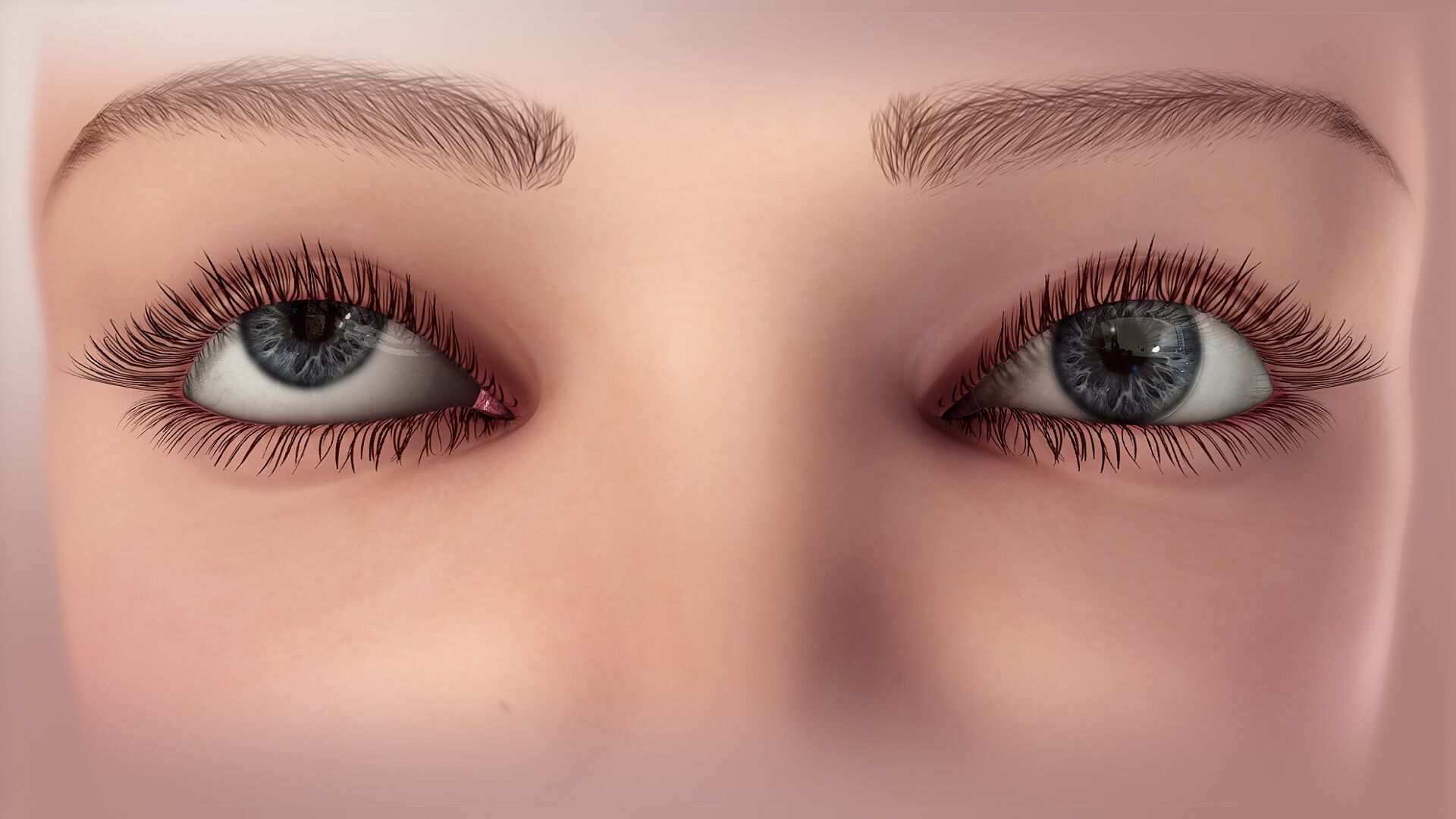|
Strabism
Strabismus is a vision disorder in which the eyes do not properly align with each other when looking at an object. The eye that is focused on an object can alternate. The condition may be present occasionally or constantly. If present during a large part of childhood, it may result in amblyopia, or lazy eyes, and loss of depth perception. If onset is during adulthood, it is more likely to result in double vision. Strabismus can occur due to muscle dysfunction, farsightedness, problems in the brain, trauma or infections. Risk factors include premature birth, cerebral palsy and a family history of the condition. Types include esotropia, where the eyes are crossed ("cross eyed"); exotropia, where the eyes diverge ("lazy eyed" or "wall eyed"); and hypertropia or hypotropia where they are vertically misaligned. They can also be classified by whether the problem is present in all directions a person looks (comitant) or varies by direction (incomitant). Diagnosis may be made ... [...More Info...] [...Related Items...] OR: [Wikipedia] [Google] [Baidu] |
Strabismus Surgery
Strabismus surgery (also: ''extraocular muscle surgery'', ''eye muscle surgery'', or ''eye alignment surgery'') is surgery on the extraocular muscles to correct strabismus, the misalignment of the eyes. Strabismus surgery is a one-day procedure that is usually performed under general anesthesia most commonly by either a neuro- or pediatric ophthalmologist. The patient spends only a few hours in the hospital with minimal preoperative preparation. After surgery, the patient should expect soreness and redness but is generally free to return home. History The earliest successful strabismus surgery intervention is known to have been performed on 26 October 1839 by Johann Friedrich Dieffenbach on a 7-year-old esotropic child; a few earlier attempts had been performed in 1818 by William Gibson of Baltimore, a general surgeon and professor at the University of Maryland. The idea of treating strabismus by cutting some of the extraocular muscle fibers was published in American newspapers ... [...More Info...] [...Related Items...] OR: [Wikipedia] [Google] [Baidu] |
Amblyopia
Amblyopia, also called lazy eye, is a disorder of sight in which the brain fails to fully process input from one eye and over time favors the other eye. It results in decreased vision in an eye that typically appears normal in other aspects. Amblyopia is the most common cause of decreased vision in a single eye among children and younger adults. The cause of amblyopia can be any condition that interferes with focusing during early childhood. This can occur from poor alignment of the eyes (strabismic), an eye being irregularly shaped such that focusing is difficult, one eye being more nearsighted or farsighted than the other (refractive), or clouding of the lens of an eye (deprivational). After the underlying cause is addressed, vision is not restored right away, as the mechanism also involves the brain. Amblyopia can be difficult to detect, so vision testing is recommended for all children around the ages of four to five. Early detection improves treatment success. Glasse ... [...More Info...] [...Related Items...] OR: [Wikipedia] [Google] [Baidu] |
Hypertropia
Hypertropia is a condition of misalignment of the eyes ( strabismus), whereby the visual axis of one eye is higher than the fellow fixating eye. Hypotropia is the similar condition, focus being on the eye with the visual axis lower than the fellow fixating eye. Dissociated vertical deviation is a special type of hypertropia leading to slow upward drift of one or rarely both eyes, usually when the patient is inattentive. Presentation Associated defects Refractive errors such as hyperopia and anisometropia may be associated abnormalities found in patients with vertical strabismus. The vertical miscoordination between the two eyes may lead to * Strabismic amblyopia, (due to deprivation / suppression of the deviating eye) * cosmetic defect (most noticed by parents of a young child and in photographs) * Face turn, depending on presence of binocular vision in a particular gaze * diplopia or double vision - more seen in adults (maturity / plasticity of neural pathways) and supp ... [...More Info...] [...Related Items...] OR: [Wikipedia] [Google] [Baidu] |
Exotropia
Exotropia is a form of strabismus where the eyes are deviated outward. It is the opposite of esotropia and usually involves more severe axis deviation than exophoria. People with exotropia often experience crossed diplopia. Intermittent exotropia is a fairly common condition. "Sensory exotropia" occurs in the presence of poor vision in one eye. Infantile exotropia (sometimes called "congenital exotropia") is seen during the first year of life, and is less common than "essential exotropia" which usually becomes apparent several years later. The brain's ability to see three-dimensional objects depends on proper alignment of the eyes. When both eyes are properly aligned and aimed at the same target, the visual portion of the brain fuses the two forms from the two eyes into a single image. When one eye turns inward, outward, upward, or downward, two different pictures are sent to the brain. Thus, the brain can no longer fuse the two images coming from the two eyes. This causes loss ... [...More Info...] [...Related Items...] OR: [Wikipedia] [Google] [Baidu] |
Esotropia
Esotropia is a form of strabismus in which one or both eyes turns inward. The condition can be constantly present, or occur intermittently, and can give the affected individual a "cross-eyed" appearance. It is the opposite of exotropia and usually involves more severe axis deviation than esophoria. Esotropia is sometimes erroneously called "lazy eye", which describes the condition of amblyopia; a reduction in vision of one or both eyes that is not the result of any pathology of the eye and cannot be resolved by the use of corrective lenses. Amblyopia can, however, arise as a result of esotropia occurring in childhood: In order to relieve symptoms of diplopia or double vision, the child's brain will ignore or "suppress" the image from the esotropic eye, which when allowed to continue untreated will lead to the development of amblyopia. Treatment options for esotropia include glasses to correct refractive errors (see accommodative esotropia below), the use of prisms and/or ortho ... [...More Info...] [...Related Items...] OR: [Wikipedia] [Google] [Baidu] |
Ophthalmology
Ophthalmology ( ) is a surgical subspecialty within medicine that deals with the diagnosis and treatment of eye disorders. An ophthalmologist is a physician who undergoes subspecialty training in medical and surgical eye care. Following a medical degree, a doctor specialising in ophthalmology must pursue additional postgraduate residency training specific to that field. This may include a one-year integrated internship that involves more general medical training in other fields such as internal medicine or general surgery. Following residency, additional specialty training (or fellowship) may be sought in a particular aspect of eye pathology. Ophthalmologists prescribe medications to treat eye diseases, implement laser therapy, and perform surgery when needed. Ophthalmologists provide both primary and specialty eye care - medical and surgical. Most ophthalmologists participate in academic research on eye diseases at some point in their training and many include research as p ... [...More Info...] [...Related Items...] OR: [Wikipedia] [Google] [Baidu] |
Exotropia
Exotropia is a form of strabismus where the eyes are deviated outward. It is the opposite of esotropia and usually involves more severe axis deviation than exophoria. People with exotropia often experience crossed diplopia. Intermittent exotropia is a fairly common condition. "Sensory exotropia" occurs in the presence of poor vision in one eye. Infantile exotropia (sometimes called "congenital exotropia") is seen during the first year of life, and is less common than "essential exotropia" which usually becomes apparent several years later. The brain's ability to see three-dimensional objects depends on proper alignment of the eyes. When both eyes are properly aligned and aimed at the same target, the visual portion of the brain fuses the two forms from the two eyes into a single image. When one eye turns inward, outward, upward, or downward, two different pictures are sent to the brain. Thus, the brain can no longer fuse the two images coming from the two eyes. This causes loss ... [...More Info...] [...Related Items...] OR: [Wikipedia] [Google] [Baidu] |
Esotropia
Esotropia is a form of strabismus in which one or both eyes turns inward. The condition can be constantly present, or occur intermittently, and can give the affected individual a "cross-eyed" appearance. It is the opposite of exotropia and usually involves more severe axis deviation than esophoria. Esotropia is sometimes erroneously called "lazy eye", which describes the condition of amblyopia; a reduction in vision of one or both eyes that is not the result of any pathology of the eye and cannot be resolved by the use of corrective lenses. Amblyopia can, however, arise as a result of esotropia occurring in childhood: In order to relieve symptoms of diplopia or double vision, the child's brain will ignore or "suppress" the image from the esotropic eye, which when allowed to continue untreated will lead to the development of amblyopia. Treatment options for esotropia include glasses to correct refractive errors (see accommodative esotropia below), the use of prisms and/or ortho ... [...More Info...] [...Related Items...] OR: [Wikipedia] [Google] [Baidu] |
Vision Disorder
A vision disorder is an impairment of the sense of vision. Vision disorder is not the same as an eye disease. Although many vision disorders do have their immediate cause in the eye, there are many other causes that may occur at other locations in the optic pathway. Causes There are many eye conditions that can lead to vision disorder. Some of which are as follows: *Age-Related Macular Degeneration (ARMD): ARMD is a retinal degeneration disease specifically associated with macula blood vessels, which can result in central vision impairment. It is strongly linked to advancing age, as well as European ancestry. * Bulging eyes: where the eye (one or both) protrudes or distends out of its orbit. Left untreated, bulging eyes may lead to eye dryness, pain and vision loss * Cytomegalovirus (CMV) Retinitis: This is an inflammation of the retina caused by infection, which can result in blindness. It occurs in people experiencing suppressed immune systems, most commonly by Acquired Immu ... [...More Info...] [...Related Items...] OR: [Wikipedia] [Google] [Baidu] |
Suppression (eye)
Suppression of an eye is a subconscious adaptation by a person's brain to eliminate the symptoms of disorders of binocular vision such as strabismus, convergence insufficiency and aniseikonia. The brain can eliminate double vision by ignoring all or part of the image of one of the eyes. The area of a person's visual field that is suppressed is called the suppression scotoma (with a scotoma meaning, more generally, an area of partial alteration in the visual field). Suppression can lead to amblyopia. Effect Nobel-prize winner David H. Hubel described suppression in simple terms as follows: :"Suppression is familiar to anyone who has trained himself to look through a monocular microscope, sight a gun, or do any other strictly one-eye task, with the other eye open. The scene simply disappears for the suppressed eye." David H. Hubel: ''Eye, Brain, and Vision'', Chapter 9 "Deprivation and development"section "Strabismus" Published online by Harvard Medical School (downloaded 30 Septe ... [...More Info...] [...Related Items...] OR: [Wikipedia] [Google] [Baidu] |
Convergence Insufficiency
Convergence insufficiency is a sensory and neuromuscular anomaly of the binocular vision system, characterized by a reduced ability of the eyes to turn towards each other, or sustain convergence. Symptoms The symptoms and signs associated with convergence insufficiency are related to prolonged, visually demanding, near-centered tasks. They may include, but are not limited to, diplopia (double vision), asthenopia (eye strain), transient blurred vision, difficulty sustaining near-visual function, abnormal fatigue, headache, and abnormal postural adaptation, among others. In some cases, difficulty with making eye contact have been noted as a complaint amongst those affected. Note that some Internet resources confuse convergence and divergence dysfunction, reversing them. Diagnosis Diagnosis of convergence insufficiency is made by an eye care professional skilled in binocular vision dysfunctions, such as an orthoptist, to rule out any organic disease. Convergence insufficiency is ch ... [...More Info...] [...Related Items...] OR: [Wikipedia] [Google] [Baidu] |






